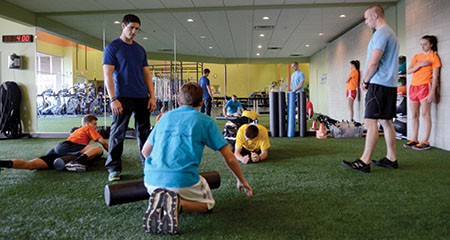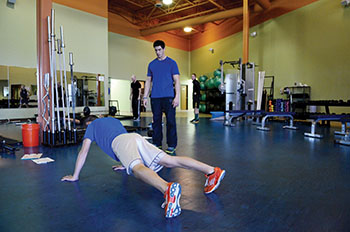“Wow, I really regret that workout,” said no one ever.
 Walk into State of Fitness on an average day and visitors not only see that statement painted on the wall, but they will enter into a cacophony of sound and activity.
Walk into State of Fitness on an average day and visitors not only see that statement painted on the wall, but they will enter into a cacophony of sound and activity.
Amid weights clanging, upbeat music and machines humming, it’s Thursday and Michigan State University kinesiology alumnus Justin Grinnell is working with a small group of high school students involved with the Sports Performance Academy.
The kids are scattered around the gym. There are those working with Grinnell, and others who are working with trainers—nearly all of whom are either current MSU students or recent graduates of the university’s kinesiology programs.
Grinnell is intently watching the kids do jumping squats while lifting five-pound weights with one arm. It’s a tricky move and some of them aren’t doing the squat correctly—but Grinnell is patient. He doesn’t get mad or frustrated; he simply demonstrates the move and asks them to try again.
An incredibly driven person, “How bad do you want it?” has become a mantra of Grinnell’s. Those who know him describe him as ambitious, assertive and motivated.
So, where did one of the highest-grossing trainers to ever come out of the Michigan Athletic Club learn the science of movement?
The fundamentals
At 19, Grinnell was studying business at MSU and working at a local health supplement store to make extra money.
Was he happy? Not so much.
Restless? Definitely.
“I had no idea what I wanted to do, but people were saying I had a knack for training,” Grinnell said. “It was when I began training my brother for the Major League Baseball draft that I thought, ‘I can do this.’”
An athlete in high school, Grinnell was always interested in fitness and had become a bodybuilder. Heading into his sophomore year at MSU, Grinnell decided to take it to the next level and switched his major to kinesiology, health promotion; he became a certified trainer and worked in a local gym.
“The first thing I realized was that I needed to learn more about the science behind exercise. I knew about nutrition but I needed the base the ‘Kin’ major offered me,” Grinnell said. “It gave me the scientific knowledge that backed up what I had already learned in the real world.”
But Grinnell didn’t want to just graduate, he wanted to be the best—“not just a meathead bodybuilder,” he added.
“There were a couple professors who really pushed me,” Grinnell said. “While at MSU, I had opportunities to work with those who were autistic or in wheelchairs … basically, I learned how to work with people. I conversed with other experts and trainers in the field so I knew what I was talking about.”
Things took off after graduation in 2004. Grinnell got married—to another kinesiology graduate—and began working at the MAC in East Lansing as a trainer. While there, he built an intern program that became highly sought-after by kinesiology students.
After four years and loads of hard work, Grinnell began asking questions many pose throughout their professional lives: “How can I get better? What’s next for my career?”
At the same time, kinesiology graduate and physical trainer Rebecca Klinger was asking the same question. And, after some prompting from a real estate friend to open State of Fitness in its current location, Grinnell and Klinger became willing to take the risk of business ownership.
And into the deep end they jumped.
A new chapter
Grinnell, now 31, and Klinger are co-owners of State of Fitness, a unique exercise and training facility for all ages and fitness levels, located on Grand River in East Lansing. The gym has become a well-oiled machine, fueled by the high energy of its owners and staff. At the end of 2012, there were six MSU kinesiology graduates and 13 MSU student interns working with Grinnell.
Ben Boudro, an exercise physiology graduate student and current trainer at State of Fitness, said Grinnell embodies all the qualities of a true leader.
“I sometimes get to the gym at 4:30 a.m. and Justin is already there, and he’ll stay until seven at night,” said Boudro. “He also meshes well with different personalities—he finds a way to connect then uses that connection to make it the best workout a person has ever had.”
 Grinnell has created an innovative intern program and considers it a feeder system. He says that, on occasion, there are even those that return for a second internship.
Grinnell has created an innovative intern program and considers it a feeder system. He says that, on occasion, there are even those that return for a second internship.
Jo Hartwell, lead advisor for the Department of Kinesiology, has known Grinnell a number of years. “We encourage the students in the kinesiology program to get out and do,” Hartwell said. “Justin is a good example of an alumnus giving back to the community and encouraging students to do the same.”
Each month, Hartwell sends out a newsletter to students and graduates that typically highlights jobs or internships, and nearly every month Grinnell is seeking one or both.
“A lot of interns don’t get much out of their internships, and I don’t think that’s fair,” remarked Grinnell. “I’ve got to always be on my toes, so they get the best education. I have to hold up my end and give students a great experience.”
Now, after three years in business, Grinnell feels the company is doing well with a solid business model and efficient staff. Marketing-wise, Grinnell has written columns for a number of years for local fitness magazine Healthy & Fit as well as national magazine Muscle & Fitness. He also has a blog (www.grinnelltraining.com) and is currently working on an e-book about different approaches to nutrition.
Yet, challenges within the industry remain.
“Unfortunately, there aren’t many places like this [State of Fitness] that are qualified to offer sound advice,” Grinnell adds. “We are going to start seeing fewer and fewer massive gyms, and in the next five years I know we’ll see an explosion in the demand for personal trainers.”
Hartwell couldn’t agree more.
“Personal trainers are definitely in demand,” she said. “A Bachelor of Science in kinesiology provides an excellent foundation. Students are prepared by learning everything there is to know about the human body—and that, combined with a recognized personal trainer certification, makes our graduates very marketable.”
As for the future, Grinnell and Klinger hope to open another facility within the next couple of years, which means more staff—good news for the local economy and MSU kinesiology graduates.
Until then, Grinnell will keep asking himself: “How bad do you want it?”
And then he’ll go get it.
BY SARAH WARDELL




